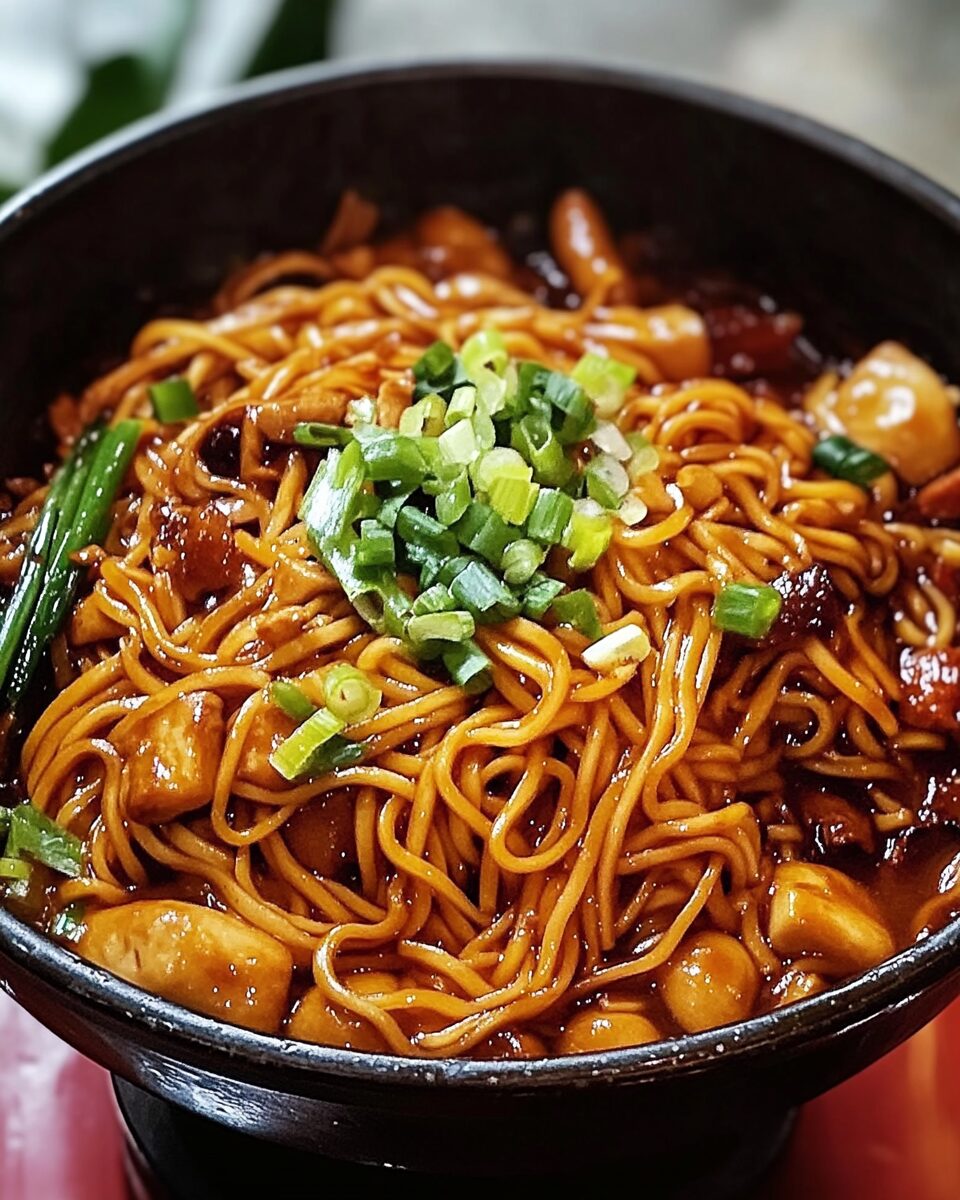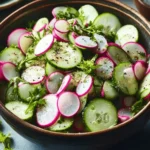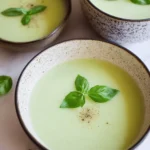This quick and flavorful stir-fry combines tender chicken strips, fresh vegetables, and chewy Hokkien noodles in a savory sauce. Perfect for busy weeknights, this dish comes together in just 20 minutes, delivering a satisfying meal the whole family will enjoy.
FULL RECIPE
Ingredients
- 400g fresh Hokkien noodles
- 2 tablespoons vegetable oil
- 2 garlic cloves, minced
- 1 small onion, thinly sliced
- 250g chicken breast, thinly sliced
- 1 carrot, julienned
- 1 red bell pepper, thinly sliced
- 100g snow peas, trimmed
- 2 green onions, cut into 5cm lengths
1.Sauce
- 2 tablespoons oyster sauce
- 1 tablespoon light soy sauce
- 1 tablespoon dark soy sauce
- 1 tablespoon hoisin sauce
- 1 teaspoon sesame oil
- 1/2 teaspoon sugar
- 1/4 teaspoon white pepper
- 2 tablespoons water
Directions
- Prepare the sauce by combining all sauce ingredients in a bowl; set aside.
- Place Hokkien noodles in a bowl of hot water for 1 minute to loosen. Drain and set aside.
- Heat 1 tablespoon of oil in a large wok or skillet over high heat. Add garlic and onion; stir-fry for 30 seconds until fragrant.
- Add chicken slices; stir-fry for 2–3 minutes until cooked through. Remove and set aside.
- In the same wok, add remaining oil. Add carrot, bell pepper, and snow peas; stir-fry for 2 minutes until just tender.
- Return chicken to the wok along with the noodles and green onions. Pour in the sauce.
- Toss everything together for 2–3 minutes until well combined and heated through.
- Serve hot, garnished with additional green onions if desired.
Nutritional Information
- Calories: 450
- Protein: 30g
- Fat: 12g
- Carbohydrates: 55g
- Fiber: 5g
- Sodium: 900mg
Cultural Significance of Hokkien Noodles
Hokkien noodles are deeply rooted in the culinary traditions of Southeast Asia, especially in Malaysia and Singapore, where they are beloved for their rich, smoky flavor and chewy texture. These noodles are a staple of hawker food culture and are often associated with comfort food that brings back memories of home-cooked meals and late-night street food runs.
Origins of the Dish
The term “Hokkien” refers to a Chinese dialect group originating from Fujian province in China. When Chinese immigrants settled in Malaysia and Singapore, they brought their culinary heritage with them. Over time, Hokkien noodles evolved into a unique regional specialty, blending traditional Chinese techniques with local Southeast Asian flavors.
Types of Hokkien Noodles
There are two main types of Hokkien noodles: the Singaporean-style which is typically stir-fried in a seafood broth with a light color, and the Malaysian-style, which is darker and often cooked with dark soy sauce. The version in this recipe is closer to the Malaysian stir-fry variant, offering deep umami flavors and satisfying textures.
Key Flavor Components
The sauce in Hokkien noodles is one of the most defining features of the dish. A balance of oyster sauce, soy sauce, hoisin, sesame oil, and white pepper provides a rich, savory base that clings to every strand of noodle and coats the vegetables and meat evenly.
Protein Options and Variations
While this recipe uses chicken, it is common to find Hokkien noodles made with a variety of proteins such as pork, beef, shrimp, or even tofu for a vegetarian version. The flexibility in protein options allows home cooks to tailor the dish to suit dietary preferences and availability.
Vegetable Combinations
The vegetables in this recipe, such as carrots, bell peppers, and snow peas, offer both crunch and freshness. However, other vegetables like bok choy, bean sprouts, mushrooms, or napa cabbage can be substituted or added for more variety and nutrition.
Noodle Preparation Techniques
Proper preparation of the noodles is crucial. Fresh Hokkien noodles are typically packed in a vacuum seal and can be quite sticky out of the bag. Soaking them in hot water for a minute helps loosen and separate the strands, making them easier to stir-fry and preventing clumping.
Wok Hei: The Smoky Element
Wok hei, or “breath of the wok,” is a prized flavor that comes from stir-frying food at high heat in a seasoned wok. Achieving wok hei adds depth and a subtle smokiness to the noodles, elevating the dish from home-cooked to restaurant-quality.
Balancing Texture and Flavor
The dish succeeds because of the balance it strikes—soft, chewy noodles, tender chicken, crisp vegetables, and a rich, glossy sauce. The texture combination is key in making each bite satisfying and engaging.
Meal Prep and Storage Tips
Hokkien noodles can be made in advance and stored in the refrigerator for up to three days. When reheating, a quick stir-fry in a hot pan will help retain texture and prevent sogginess. For best results, store the sauce separately and mix it in while reheating.
Serving Suggestions
This dish can be served on its own as a complete meal, but it also pairs well with side dishes such as spring rolls, wonton soup, or a light cucumber salad. Garnishing with fried shallots or chili oil adds extra layers of flavor and visual appeal.
Popular Among All Ages
One reason Hokkien noodles are so popular is their universal appeal. Kids enjoy the mild and savory taste, while adults appreciate the complexity of the sauce and the satisfying chew of the noodles. It’s a family-friendly dish that’s both nutritious and indulgent.
Regional Differences and Interpretations
Different regions put their own spin on Hokkien noodles. In Penang, for example, they might be cooked in prawn stock for a seafood-forward taste. Meanwhile, in Kuala Lumpur, darker soy sauce and pork lard are more commonly used, creating a richer, heavier flavor profile.
Making it Spicy
For those who enjoy heat, this dish can easily be adapted to include chili paste or fresh sliced chilies. Sambal oelek or chili garlic sauce can be stirred into the sauce mixture or added at the end to provide a customizable level of spiciness.
Health Considerations
While traditionally indulgent, Hokkien noodles can be made healthier by reducing the oil content, increasing the proportion of vegetables, and using lean proteins. Choosing low-sodium sauces and fresh noodles over processed ones also contributes to a more nutritious version.
Gluten-Free Modifications
To make this dish gluten-free, you can substitute the Hokkien noodles with rice noodles or gluten-free egg noodles. Additionally, make sure to use certified gluten-free versions of soy sauce and hoisin sauce, as traditional varieties typically contain wheat.
Importance of Mise en Place
Stir-frying happens quickly, so having all ingredients prepared and within arm’s reach is essential. Mise en place ensures smooth cooking and prevents overcooking any single component, which is particularly important for maintaining texture and flavor integrity.
Common Mistakes to Avoid
Overcrowding the pan can lead to steaming instead of stir-frying, which diminishes the flavor. Another common mistake is using too little heat, which prevents the sauce from caramelizing and the noodles from absorbing all the flavors effectively.
Cooking Tools and Equipment
A traditional carbon steel wok is ideal for this recipe, as it retains high heat and develops seasoning over time. However, a large nonstick skillet or sauté pan can work as well, provided it’s heated properly and large enough to hold all the ingredients.
Conclusion
Everyday Hokkien noodles are more than just a quick stir-fry—they represent the rich tapestry of Asian culinary traditions adapted to modern kitchens. This dish showcases how a few pantry staples can come together to create something deeply flavorful, comforting, and versatile. Whether you’re cooking for yourself, your family, or entertaining guests, Hokkien noodles deliver satisfaction and a sense of cultural connection. With endless customization options and a simple cooking process, it’s a recipe you’ll come back to time and again.






